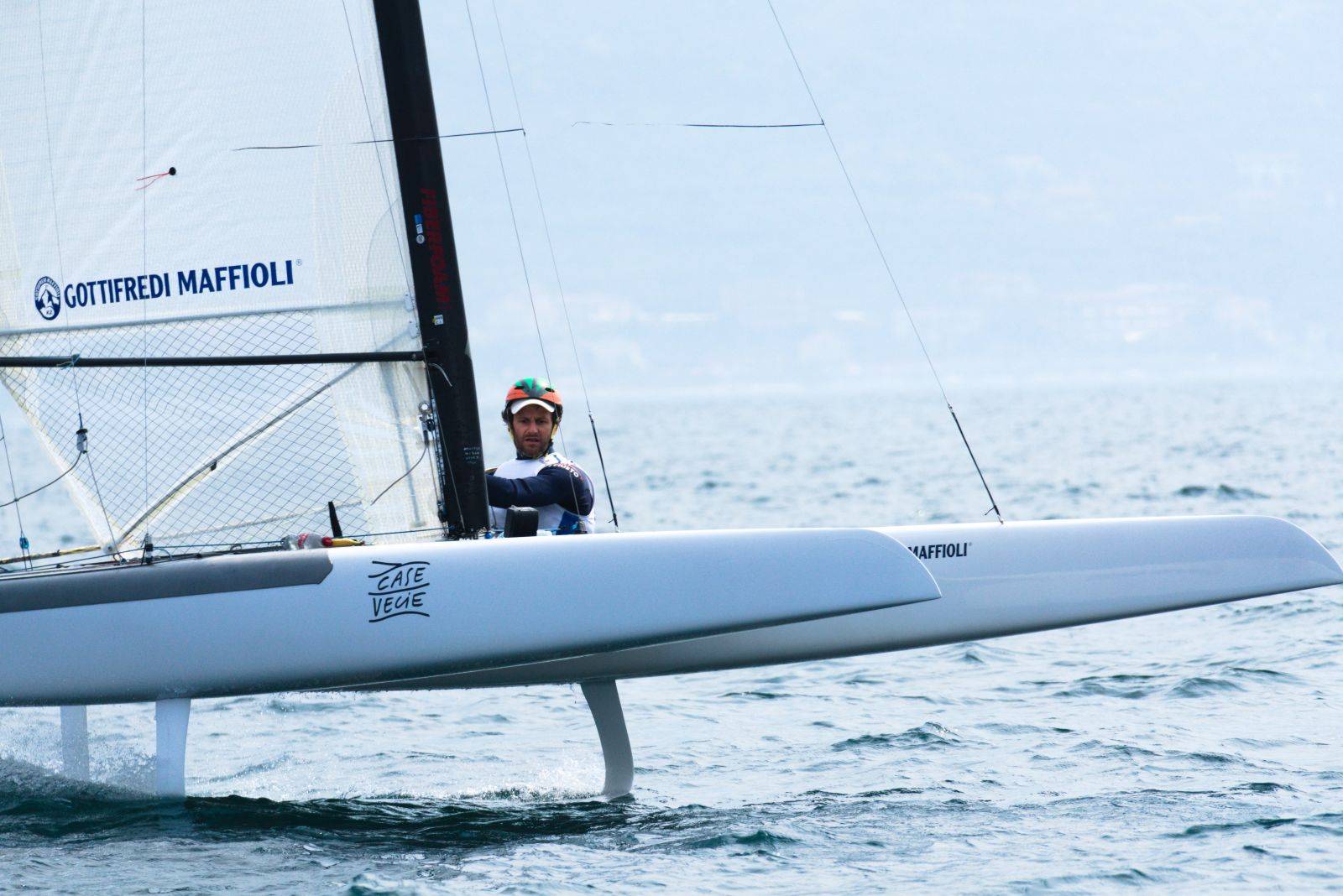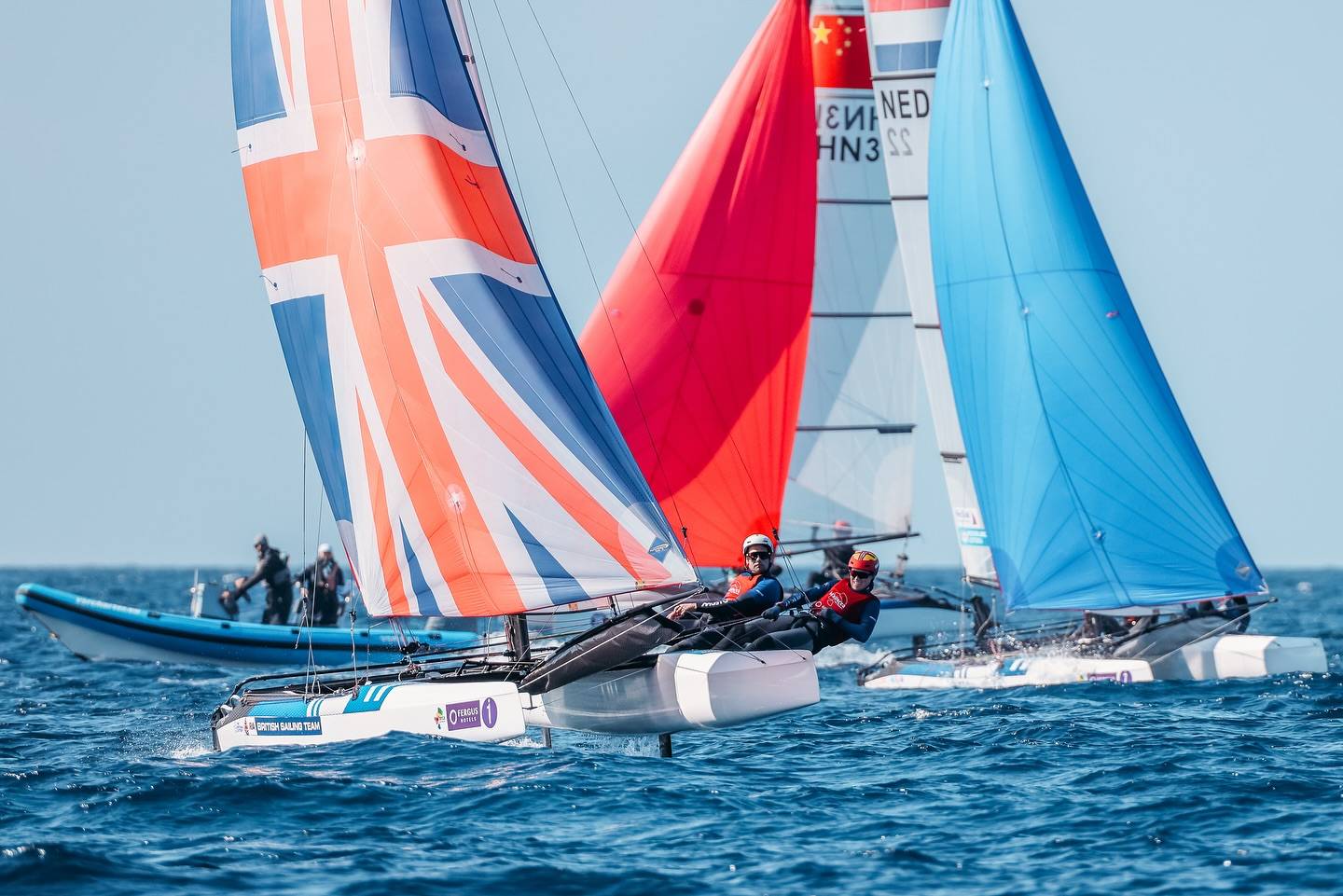Gunboat 68: Boards Design & Construction
Excellent technical series done by the new Gunboat company. A detailed description & report of the Gunboat 68 boards design alternatives weighted by VPLP & its final construction, sent by Gunboat. Renders of the G68 here. More details at gunboat.com/series/gunboat68
——————————–
———————————
Gunboat 68 . Putting the Power Down
Counting down to the launch of the all-new Gunboat 68 next fall we continue to share insight into the design and build of this long-awaited, cutting-edge performance cruising cat. Construction is proceeding on schedule at our new state-of-the-art facility in La Grande Motte, France. So far in our series of articles we have looked at the hulls, the “skin”, and the internal structure, the “bones”. This time we’re looking at the all-important daggerboards – the means by which the power of the rig is transferred through the structure and into forward motion through the water.
“When we started thinking about daggerboards, in addition to speed and comfortable motion, two
important specifications we set were that they needed to interfere as little as possible with the interior, and when raised they needed to deliver a draft of 1.2m (4ft),” says Gunboat’s Benoit Lebizay. “The latter limitation is to protect the saildrives, which have a draft of 1.1m (3ft 7in), in the event of a grounding. The daggerboard casings need to be able to withstand collision and the daggerboards themselves need to shear off without compromising the hull if grounded or in a collision at speed.”
With both performance and evolution being part of Gunboat’s DNA, a deep level of research went into design and engineering – we’ll walk you through the process we took to deliver a foil package that will ensure the fastest, most comfortable and above all, safest ride on the Gunboat 68!
FINDING THE RIGHT BOARD DESIGN
When we were starting off down this road in mid-2016, the world had already gone foil-crazy: curved
boards or straight, L- or J-profile, tips or no tips, and the full range of development and designs. A lot was already known about the performance of the various options, and most of that knowledge is held by our design partners VPLP. We mined all of their extensive experience to come up with the solution for the Gunboat 68 that found the perfect balance of performance, stability, and ease of use.
“We ran a whole range of board concepts,” says Vincent Lauriot-Prévost, the ‘LP’ of VPLP. “It’s all about side force and vertical lift, and it’s driven by a brief that includes other practical parameters like reliability, interference with the interior, the simplicity of maneuvers and the versatility of cruising and racing versions. All the candidates we tested came from either ORMA trimarans, foiling and non-foiling IMOCA monohulls and the past three America’s Cup multihull editions. Ultimately it’s about finding the right compromise for this program.”
All in all we did 14 – that’s fourteen – iterations of board VPPs, running them with different displacements, rig heights, symmetric and asymmetric boards – every variable there is. We also checked true wind hull fly speeds so we could stick to our safety targets: the performance-rigged Gunboat 68 shouldn’t fly a hull below 16 knots TWS, or over 20kts for the cruising version.
Without flying the platform, boards with foils or tips could not only generate lift, reducing wetted surface area and therefore drag, but could also help to improve comfort and stabilize the platform by preventing ‘heaving’ (sudden vertical movement when sailing through waves). We wanted to explore the options.
First we looked at curved boards. They create lift and the added bonus is that the boards and casings match the profile of the outside of the hull so they’re less intrusive below. VPLP ran a VPP study on a variety of curved boards, with and without tips, but they all showed that curved boards bring the center of lift inboard, actually reducing righting moment, which will make a hull fly earlier. Safety is a key part of the Gunboat philosophy, so much so that we increased the beam of the Gunboat 68, and therefore the righting moment, to make her a safer boat. Further, the build complications of curved molds added more complexity for very little gain. We opted against curved boards.
Image: The results of the VPP study of curved boards sent us in a different direction.
“Then we looked at L-shaped boards with down tips to provide more lift,” says VPLP’s Xavier Guilbaud. “They were quite promising in terms of performance for downwind and reaching races like the Caribbean 600, but it was too radical for a round-the-cans regatta – and you end up with a draft of 2m (6ft 7in), which was a dealbreaker.”
And it wasn’t just a draft issue. The VPP showed L-tips provided more lift, but at normal boat speeds, below 20 knots, none generated enough lift to reduce wetted surface area and all of them increased drag significantly. Above 20 knots they would progressively generate lift up to around 30-40 percent of displacement, but it seemed difficult to justify adding L-tips as a standard option. Regardless of draft, they just don’t suit the Gunboat 68’s normal operating parameters.
Curved and L-shaped boards were obviously not the right option for the Gunboat 68 although everyone liked the way they reduced heaving, which adds a lot of comfort to the ride.
“The breakthrough came when we suggested using straight boards, but canting them inboard,” says Xavier. “We ran another VPP and confirmed we were onto something. This option delivered lift and, because of the cant, reduced heaving. We increased the length by 850mm and saw significant performance gains across 90 percent of the wind angles. Upwind, asymmetric boards always performed better above 15 knots TWS, but only if your crew switches boards on every tack. This revealed another advantage of symmetric boards: you can leave them both down, which is great for cruising.”
– Xavier Guildbaud, Naval Architect, VPLP – Vannes
“It may be surprising to some people, but the choice which best fits the brief of a performance cruising catamaran like the Gunboat 68 is simple canted straight boards,” Xavier continues. “We want to give owners some options so we selected three configurations for the catalog: short symmetrical boards for cruising at one end, high aspect ratio long asymmetrical boards for pure racing at the other, and in the middle the long symmetrical boards we’ll see on Gunboat 68-01. They are the perfect compromise for the owner wanting to run both cruising and racing programs, and they all fit in the same trunk geometry, structure, and longitudinal location.”
Image: A diagram showing some of the board profiles that were part of the VPLP study.
“Gunboat has always been out front in the performance cruising market so we’re ready to push the boundaries,” adds Lauriot-Prévost. “In the future that may include concepts like straight boards with horizontal tips or heave-damping Z-foils for performance and comfort at sea, but for Gunboat 68-01 none of these options fit the original brief because it is impossible to fit the boards from deck or satisfy the draft limit. VPLP’s toolbox is full of different concepts – it is all about where we put the cursor between practicality and performance.”
BUILDING THE BOARDS
All the VPP work had shown that the best option for the owner of Gunboat 68-01 was long symmetrical straight boards. Working with VPLP, our engineering team decided that the boards will be raised by a line on an integrated and Gunboat-styled gantry crane using electric winches in the forward cockpit. The boards need to be built in pre-preg carbon and cured in an autoclave, as that optimized everything: strength, weight and quality. It produces a consistent part with perfect consolidation. We also knew that we wanted everything – daggerboard, casing, gantry and bearings – delivered as a single assembly. This would ensure the structural strength required of a component that helps to transfer serious loads between bulkheads, hull and deck – its not just there to keep the water out.
To build the boards, we sought a partner with a consistent track record of excellence in producing carbon components, a partner for the long run, searching wide and then circling back to Lorima. The Lorient-based specialist is perhaps best known for its super high-performance carbon masts but Lorima seriously impressed us with the quality of the appendages it makes for race boats, most notably for the Multi 50 class.
Photo: The Multi 50 board at Lorima
“We’re very pleased to be working with Gunboat because we know their ambition matches our own,” says Lorima president, Vincent Marsaudon. “We know VPLP well. Before 2009 about 80 percent of Lorima’s work was on racing projects, and that’s how our relationship with them evolved. We’ve done all the Ultim masts and booms for them, and also foils for those boats. Then, when foils took off, we were chosen as a trusted partner to build foils for the Multi 50 class. We’ve done 12 foils for them now, six pairs, with ultrasound inspection and load testing to ensure they met specification.”
“We’ll build the Gunboat 68 foils in the same way we built the Multi 50 foils. We laminate CNC-machined female tooling with unidirectional carbon fiber. Foam is machine cut for an exact fit and sheer webs are laminated between the foam sections. Then the top skin is laminated with more unidirectional carbon fiber. After vacuum-bagging the foil, we put it into an autoclave at 100°C and the whole part is cured in one go, which means no blind glue joints and less than one percent porosity. After curing, the top skin will be a couple of millimeters out, so the board is CNC-machined to the perfect shape before the entire board is wrapped in a layer of pre-preg carbon to hold it together.”
FROM THE BOATBUILDERS:
“Because the case and bearings come as one finished piece, the bearings are all perfectly aligned and it makes the job of installation very accurate,” says Gwenael Bardou, Composites and Assembly Manager at Gunboat. “We get a precisely molded component and, because the components are already structurally integrated, reducing how much reinforcement is needed in the boat, which saves weight.”
Images Below: Port daggerboard trunk installed in the Gunboat 68, and the corresponding 3D model.
Photo left: Load testing a Multi 50 foil at Lorima. Gunboat 68 boards will be tested in exactly the same way, with actual load testing, not just ultrasound.
And how strong is it? The lower bearing in the daggerboard casing (and therefore the daggerboard itself) can handle loads of up to 20 tonnes. To put that another way, you could hang six Lincoln Navigators or eight Range Rovers from the daggerboard.
In this exciting era for foil development (and for fast sailing in general), we’ve thoroughly enjoyed the no-stone-unturned approach to finding the right boards for the Gunboat 68 and can’t wait to see her deliver on the water!
———————
——————–































I just heard that my great sailing friend and former CEO of Hobiecat Europe has passed. May The endless oceans…
...Report was sent by an F18 Sailor, if you want Hobies reported send your own, we'll publish as usual. Cheers.
Looks like in your report the Hobies are not really present. Suggest to rewrite the article.
Thanks for the great report Wik. Great battle.
If I correctly read the results the overall winner this year is a Hobie16